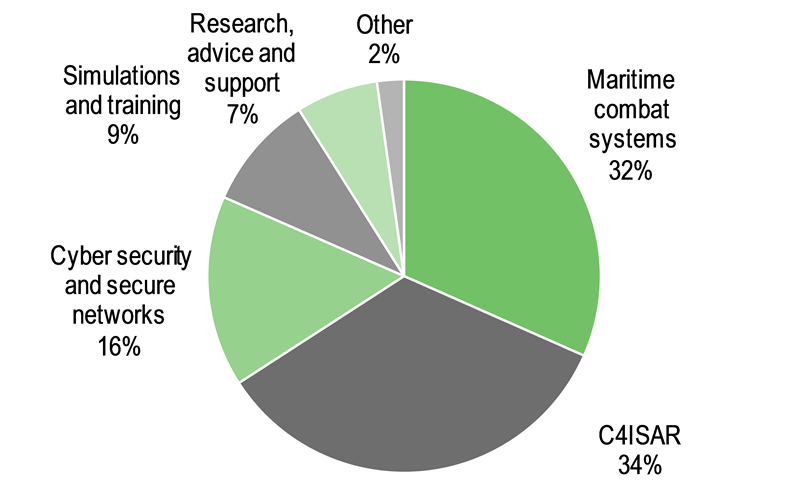The salient features of the interim results are as follows:
■
Reported closing order book of £102.5m was down from the H118 report of £132.1m and FY17 £136.5m. The company cited delays for the lower order intake in the year. However, FY19 has a larger than normal concentration of opportunities, as the contracts expected in FY18 are pushed out into FY19.
■
Reported revenues were £111.8m (FY17: £112.7m).
■
Reported adjusted operating profit was £15.6m (FY17: £14.5m).
■
Reported adjusted EPS was 30.00p (FY17: 27.93p) including one-off tax credits.
■
Reported DPS was 8.2p (FY17: 7.1p), a 15.5% increase in line with the group’s progressive dividend policy.
■
Net cash of £11.3m (FY17 £8.5m) was up from £5.7m at the half year, where a net cash flow had been expected on higher operating profit contribution. Within the year the company paid £2.5m as the final payment on MCL and £3.5m on the 23% EID acquisition.
Exhibit 1: H1 and FY divisional analysis
April year end (£m) |
H117 |
H217 |
FY17 |
H118 |
H218 |
FY18 |
FY % change |
|
|
|
|
|
|
|
|
Order intake |
|
|
|
|
|
|
|
MASS |
|
|
32 |
|
|
29.1 |
(9.1)% |
SCS* |
|
|
3 |
|
|
|
|
SEA |
|
|
31.4 |
|
|
27 |
(14.0)% |
MCL |
|
|
23.3 |
|
|
12.1 |
(48.1)% |
EID |
|
|
18.9 |
|
|
8.4 |
(55.6)% |
Total order intake |
|
|
108.6 |
|
|
76.6 |
-29.5% |
Order book |
|
|
|
|
|
|
|
MASS |
|
|
49.4 |
42.6 |
|
40.9 |
(17.2)% |
SCS* |
|
|
|
|
|
|
|
SEA |
|
|
44 |
41.4 |
|
33.1 |
(24.8)% |
MCL |
|
|
15.5 |
18.4 |
|
10.3 |
(33.5)% |
EID |
|
|
27.6 |
29.7 |
|
18.2 |
(34.1)% |
Total order book |
|
|
136.5 |
132.1 |
|
102.5 |
(24.9)% |
Revenue |
|
|
|
|
|
|
|
MASS |
14.5 |
18 |
32.5 |
17.2 |
20.3 |
37.5 |
15.4% |
SCS* |
5 |
0 |
5 |
|
0 |
|
|
SEA |
18 |
26.4 |
44.4 |
15.7 |
22.1 |
37.8 |
(14.9)% |
MCL |
7.9 |
6.9 |
14.8 |
5.1 |
12.3 |
17.4 |
17.6% |
EID |
4.6 |
11.4 |
16 |
6.8 |
12.3 |
19.1 |
19.4% |
Total revenue |
50 |
62.7 |
112.7 |
44.8 |
67 |
111.8 |
-0.8% |
Adjusted operating profit |
|
|
|
|
|
|
|
MASS |
2.4 |
3.5 |
5.9 |
2.549 |
4.551 |
7.1 |
20.2% |
SCS* |
-0.5 |
0.0 |
-0.5 |
|
|
|
|
SEA |
1.0 |
4.3 |
5.3 |
1.0 |
3.4 |
4.4 |
-16.9% |
MCL |
0.8 |
1.3 |
2.1 |
0.2 |
1.9 |
2.1 |
2.3% |
EID |
1.4 |
2.8 |
4.2 |
1.2 |
3.5 |
4.7 |
11.0% |
HQ & Other |
(1.3) |
(1.2) |
(2.5) |
(1.3) |
(1.4) |
(2.7) |
5.8% |
Total adjusted operating profit |
3.9 |
2.8 |
14.5 |
3.6 |
7.4 |
15.6 |
7.7% |
|
|
|
|
|
|
|
|
Operating profit |
(3.2) |
4.2 |
1.0 |
0.8 |
9.2 |
10.0 |
|
Finance costs |
0.0 |
0.0 |
0.0 |
0.0 |
(0.1) |
(0.1) |
|
Profit before tax |
(3.2) |
4.2 |
1.0 |
0.8 |
9.1 |
9.9 |
|
Tax expense |
0.6 |
0.6 |
1.1 |
(0.1) |
(1.3) |
(1.4) |
|
Net income |
(2.7) |
4.8 |
2.1 |
0.6 |
7.8 |
8.5 |
|
|
|
|
|
|
|
|
|
EPS (p) reported |
6.0 |
3.1 |
9.1 |
6.3 |
13.6 |
19.9 |
118.6% |
DPS (p) |
2.2 |
4.9 |
7.1 |
2.55 |
5.65 |
8.2 |
15.5% |
Net cash |
8.5 |
|
8.5 |
5.7 |
|
11.3 |
32.9% |
Source: Company reports. Note: *SCS business was restructured into MASS and SEA in December 2016.
Exhibit 2: FY18 defence and security revenue by market segment
|
Exhibit 3: FY18 defence and security revenue by end customer
|

|

|
|
|
|
Exhibit 2: FY18 defence and security revenue by market segment
|

|
|
|
Exhibit 3: FY18 defence and security revenue by end customer
|

|
|
|
MASS (FY18 sales: £37.5m; 34% of group sales) returned to growth. A key input was the completion of the biennial joint forces exercise, driving topline and margin. The division started deliveries to the Metropolitan Police Service for the Digital Forensics Programme, secured at the end of FY17. Lower electronic warfare operational support activity was countered by higher training support (ex SCS) and cyber volumes to increase the division operating margin.
SEA (FY18 sales: £37.8m; 34% of group sales) delivered a lower top-line result, as seen in the H118 report. The higher adjusted operating margin, up from 11.1% in FY16 reflects the higher export content and a trend towards more product sales. There is a natural lull between the completed design work on the Astute Class and the increased activity on Dreadnought Class, expected to last 18-24 months. To put this in context, the submarine revenue contribution was £21.1m in FY16 and just £7.3m in FY18. While the company is taking costs out of this area, it should be noted how successful the division has been to counter this decline with other business areas, including increased export sales of torpedo launch systems. In addition, the submarine communications programme has been considerably derisked and has allowed some contingency to be released. This division is also balancing the longer term contracts and the predictability that brings, with shorter term contracts within its simulation, support and product activity. While the ROADflow product range has seen growth, it experienced tough comparisons in H218 given the prior year peak. Given the reduced research and submarine activity, the business will face restructuring during FY19 at an anticipated cost of £0.5m, targeting annual savings of £1.0m per year.
EID (FY18 £19.1m; 17% of group sales) performance exceeded group expectations, with a higher naval contribution at 60% of the division, up from 30% last year. This is expected to move back in FY19 with lower naval support work and higher intercom and radio products. The company notes that the higher bought in element will bring the division’s expected operating margin levels close to 20%. Within the year, Cohort acquired an additional 23% of EID, taking the total holding to 80% as expected, enhancing future EPS.
MCL (FY18 sales £17.4m; 17% of group sales) delivered a flat performance, with increased volume and margin offset by slightly higher overheads. The company won a further £6m contract for hearing protection systems, building on the success of the business to date. Overall, MCL is moving to shorter-term order book visibility, of around three to six months on average.
The current review and tightening of spending at the UK MOD is likely to have an ongoing impact on FY19 and beyond. However Cohort continues to broaden its exposure to different programmes and project areas. While the current order book stands at a lower level year-on-year, the company stresses this is due to contract delays rather than lack of demand. Outside the UK, Portugal is seeing a relatively robust level of spending with upgrades to maritime and land communication systems, from which EID should benefit. In addition, the company is well placed to leverage the growing requirement for defence and counter terrorism capability around the globe.
While FY18 order progression reflected delays, Cohort’s order book progression shows additional strength overall. Exhibit 4 gives a picture of the visibility of the order book across the divisions. Part of the strategy has been to stabilise and build visibility. Cohort’s delivery schedule does stretch out to 2025; however, order cover is typically in the range of 55-65% at the start of any given year. Cohort can also operate with an increasing level of shorter-term contracts, which can be supportive at the operating margin level but may not be visible in order book charts.
Exhibit 4: Delivery of the group’s order book into revenue
|

|
|
|
The company expects net cash to remain flat on FY18, as working capital is expected to rise to support contract work. However, beyond that the company expects cash contribution in FY20 to be strong, as the working capital unwinds. The group continues to be agile and will consider further suitable acquisitions.





















